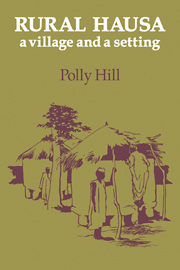Book contents
- Frontmatter
- Contents
- List of tables
- List of illustrations
- Preface
- List of abbreviations and conventions
- Map of Hausaland (after Morgan and Pugh, 1969)
- I Introduction
- II Batagarawa
- III Fathers and sons in gandu
- IV The evidence for economic inequality
- V Further aspects of inequality
- VI The sale of manured farmland
- VII Migration
- VIII Farm-labouring
- IX Local trade in grains and groundnuts
- X Individual poverty
- XI Individual viability
- XII Short-term stability
- XIII The absence of ‘class’
- XIV Concluding speculations
- Commentary, including Hausa glossary
- Bibliography
- Index
XIV - Concluding speculations
Published online by Cambridge University Press: 05 May 2010
- Frontmatter
- Contents
- List of tables
- List of illustrations
- Preface
- List of abbreviations and conventions
- Map of Hausaland (after Morgan and Pugh, 1969)
- I Introduction
- II Batagarawa
- III Fathers and sons in gandu
- IV The evidence for economic inequality
- V Further aspects of inequality
- VI The sale of manured farmland
- VII Migration
- VIII Farm-labouring
- IX Local trade in grains and groundnuts
- X Individual poverty
- XI Individual viability
- XII Short-term stability
- XIII The absence of ‘class’
- XIV Concluding speculations
- Commentary, including Hausa glossary
- Bibliography
- Index
Summary
So much for our relentless pursuit of the theme of economic inequality in Batagarawa. With the aid of the remarkable classification by economic-group which was invented by our eager informants, we have been able to avoid some of the limitations of a static approach based on the concept of a single ‘modal farmer’. As it has been our purpose to study the workings of the economy in terms of the relationship between richer and poorer farmers, it is to be hoped that no reader will suppose that we have merely replaced one modal farmer with four other dummies.
Our analysis has shown that while a farmer's short-term prospects are greatly dependent on his relative economic position, this is not necessarily true of his longer-term situation. So far as ‘mobility’ between economic-groups is concerned, the system is sticky but not set, there being no ‘peasant aristocracy’, nor institutionally under-privileged group. Nor (an associated point) is the economic system in some kind of natural stable balance, such as would automatically stultify all outside attempts to raise living standards – either by resisting all change, or by toppling in chaos when this balance was disturbed. Batagarawa is an economy in unstable equilibrium which is ripe for development.
- Type
- Chapter
- Information
- Rural HausaA Village and a Setting, pp. 189 - 198Publisher: Cambridge University PressPrint publication year: 1972

